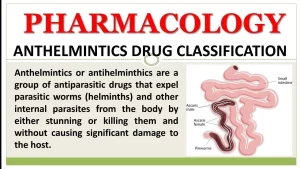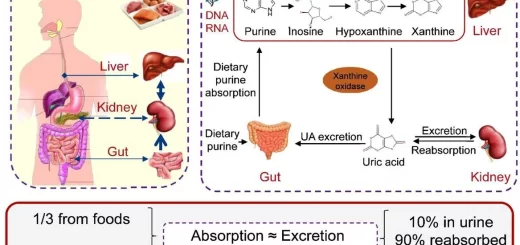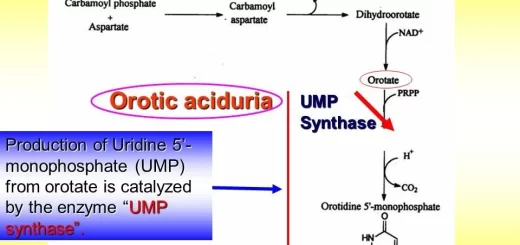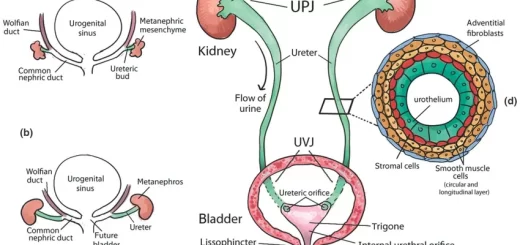Anthelminthic drugs classification, mechanism of action & Drugs used in the treatment of Cestode infections
Pharmacologic basis of the treatment of helminthic infections generally involves the interference with the integrity of parasite cells, neuromuscular coordination, or protective mechanisms against the host immunity, which leads to starvation, paralysis, and expulsion or digestion of the parasite.
Mechanism of Action of Anthelminthic Drugs
1. Drugs Affecting Cellular Integrity and Energy Production
- Inhibitors of tubulin polymerization with subsequent inhibition of cellular transport, motility, mitosis, and energy metabolism, e.g., benzimidazoles.
- Uncoupler of mitochondrial oxidative phosphorylation, they selectively prevent utilization of energy derived from respiratory electron transport for generation of ATP e.g., niclosamide.
- Drugs that form a reactive metabolite that alkylates parasite DNA lead to their death by interruption of its nucleic acid and protein synthesis, e.g., oxamniquiñe.
2. Drugs Affecting Neuromuscular Coordination
Interference with this process may occur by either inhibiting the breakdown or mimicking or enhancing the action of neurotransmitters, The result is the paralysis of an intestinal helminth and its expulsion by the normal peristaltic action of the host or its starvation to death.
- Stimulator of the nicotinic acetylcholine receptors and blockade of neuromuscular junction e.g. Pyrantel.
- Stimulator of glutamate-gated chloride channels with hyperpolarization of the nerve or muscle cell, e. g. Ivermectin.
3. Drugs Affecting the Permeability of Cells and Vacuolation of Tegument, e.g., Praziquantel, Triclabendazole.
4. Drugs Increasing the Susceptibility of the Parasite to be easily attacked by host antibodies through binding to the specific surface antigen of the worm, e.g., Praziquantel.
Drugs used in the treatment of trematode infections
Trematodes include e.g., Schistosoma (blood flukes), Heterophyes heterophyes (intestinal flukes), and Fasciola (liver flukes).
1. Praziquantel
It is a broad-spectrum anthelminthic drug effective against all species of human Schistosoma, and liver (except for F. hepatica and F. gigantica) and intestinal (eg. Heterophyes heterophyes) fluke infections. It is usually given as a single dose.
Pharmacokinetics
Most of the absorbed praziquantel is metabolized in the liver by the cytochrome P450 system into a hydroxylated polar metabolite, The efficacy of praziquantel on blood, liver, and lung fluke infections is considered to be due to the polarized metabolite form, which constitutes the majority of the praziquantel in the plasma.
Adverse Reactions
- Early. They begin within several hours after ingestion of praziquantel and may persist for about 1 day, Most common are headache, dizziness, GIT upsets, and low-grade fever.
- Late: Several days after starting praziquantel, low-grade fever, pruritus, and skin rashes may occur, probably due to the release of proteins from dying worms rather than direct drug toxicity.
Praziquantel is safe during pregnancy and lactation.
2. Oxamniquine
It is an alternative to praziquantel for the treatment of S. mansoni infections, It is not effective against & haematobium or S. japonicum.
Adverse Reactions & Contraindications
Mid symptoms start about 3 hours after a dose and last for several hours including.
- CNS manifestations: dizziness and headache are the most common.
- GIT upsets.
- Allergic reactions (pruritus and urticaria).
- Orange or red discoloration of urine may occur.
- Oxamniquine is contraindicated in pregnancy.
3. Triclabendazole
Triclabendazole is a narrow-spectrum anthelminthic benzimidazole, with activity against Fasciola (F. hepatica and F. gigantica), It is effective against Fasciola species at all stages of infection.
Pharmacokinetics
It is recommended that triclabendazole should be administered with food to enhance its absorption.
Adverse Reactions
It appears to be well tolerated in the treatment of fascioliasis, The most common adverse events associated with treatment appear to be related to the expulsion of dead or dying flukes from the hepatobiliary system, which is manifested as biliary colic, in some cases, this is associated with obstructive jaundice and elevations in serum alkaline phosphatase.
4. Nitazoxanide
Nitazoxanide is a broad-spectrum antimicrobial agent with in vitro activity against a variety of protozoa, trematodes, cestodes, nematodes, and anaerobic bacteria, Nitazoxanide is a good alternative to triclabendazole, especially for the chronic stage of Fasciola infection, It is a prodrug that is rapidly absorbed and converted to the active metabolite tizoxanide, The drug is given orally with food.
Adverse Reactions: A greenish tint to the urine is seen in most individuals taking nitazoxanide.
Drugs used in the treatment of cestode infections
Cestodes include, eg, Taenia saginata (beef tapeworm), T. solium (pork tapeworm), and Hymenolepis nana (dwarf tapeworm).
1. Praziquantel
A single dose of praziquantel results in nearly 100 % cure rates for T. saginata, and T. solium infections. H. nana infection generally needs a higher dose of praziquantel to obtain a satisfactory cure rate. Unlike other anthelmintics, it is efficiently absorbed and kills the larval stage (cysticercoids) in the submucosa.
2. Niclosamide
Niclosamide is highly effective against a wide variety of adult tapeworms, but not against tissue cestode infections, such as echinococcosis or cysticercosis. It is a second-line drug for the treatment of most cestode infections. It is also effective against Heterophyes heterophyes.
Pharmacokinetics: Only a small amount of the drug is absorbed from the gastro-intestinal tract. So, they achieve easily effective concentration against luminal parasites.
Therapeutic Uses
Taenia saginata and T. solium infections: A single dose is given in the morning on an empty stomach. With H. nana infection, a longer treatment course (up to 7 days) is necessary.
Niclosamide is administered after the patient has fasted overnight, The scolex and proximal segments of the tapeworms are killed on contact with niclosamide. A purgative (magnesium sulfate) is recommended to be given 2 hours after drug administration for rapid evacuation of the bowel from dead worms.
Adverse Reactions
Mild adverse effects: These include nausea, vomiting, diarrhea, and abdominal discomfort.
Niclosamide is safe during pregnancy.
3. Nitazoxanide
It is an alternative drug for cestode infection.
Drugs used for the treatment of tissue cestode infections
1. Praziquantel
Human cysticercosis, caused by the metacestode of T. solium, is the only larval cestode infection that can be successfully treated with praziquantel, However, several studies have reported better results with the replacement of praziquantel with albendazole.
2. Albendazole
It is the drug of choice for cestode tissue infection caused by larval cysts of the Echinococcus granulosus.
Drugs used for the treatment of tissue cestode infections
Nematodes (Human gastrointestinal nematode) include Hook worms, Ascaris lumbricoides, Trichuris trichiura, Enterobius vermicularis, and Strongyloides stercoralis.
1. Benzimidazoles
They are characterized by a broad spectrum of activity against roundworms, an ovicidal effect, and a wide safety margin, Effective drugs in this group against nematode infection include mebendazole and albendazole.
Mebendazole is indicated for the treatment of intestinal nematode infection, A single dose of mebendazole cures 95% of pinworm infections, Then, another single dose of the same drug is recommended two weeks later to avoid the risk of autoinfection by the ova left after the first dose, For the other nematode infections, the drug is taken orally in the morning and evening for three consecutive days.
Albendazole is administered in a single dose, Albendazole may be taken with or without food and the ideal choice is based on the location of the parasitic infection, Because very little is systemically absorbed if given on empty stomach, the dosing for intestinal infections in children and adults is similar, It is important to note that food increases albendazole absorption, particularly a fatty meal, Therefore, for luminal infections (e.g. ascariasis), the dose can be given on an empty stomach to reduce absorption, For systemic or extraintestinal infections, albendazole should be given with food to enhance absorption.
2. Pyrantel
It is an alternative drug for the treatment of E. vermicularis and A lumbricoides infections.
3. IVermectin
It is an alternative drug for A lumbricoides infection.
4. Nitazoxanide
It is an alternative drug for A lumbricoides infection.
WHO allows the use of mebendazole in the 2nd and 3rd trimesters of pregnancy.
Drugs used for the treatment of tissue nematode infections
Drugs for lymphatic filariasis
1. Diethylcarbamazine
Diethylcarbamazine (DEO) is used for the treatment of lymphatic filariasis. This drug kills the microfilaria, it does not effectively kill adult worms but blocks the release of microfilariae for some months after therapy. Cures may require several courses of treatment.
Due to this microfilaricidal activity of DEC, the blood is cleared of microfilariae and the opportunity for mosquito-borne transmission to occur is reduced. The macrofilaricidal action of DEC is not intended to reverse the disease, but it prevents further adult worm-associated lymphatic damage and dysfunction.
Adverse Reactions: Allergic or febrile reactions may be severe in patients with microfilaria in the blood. It requires the intake of concomitant corticosteroids.
2. Ivermectin
Like DEC, it does not effectively kill adult worms but blocks the release of microfilariae for some months after therapy. Taking ivermectin with food (specifically, a high-fat meal) greatly increases its bioavailability, Ivermectin is usually given as a single dose, However, when treating filariasis, a single dose is effective in reducing symptoms for many months but rarely induces remission, Repeated doses may be needed once or twice yearly for several years until the infection eventually subsides.
It is best to avoid the concomitant use of ivermectin with other drugs that enhance GABA activity, eg, benzodiazepines and valproic acid. It should not be used during pregnancy.
You can follow science online on Youtube from this link: Science online
You can download Science online application on google Play from this link: Science online Apps on Google Play
Types of protein synthesis inhibitors antibiotics & Uses of individual aminoglycosides
Antibacterial drugs definition, use & types, Penicillin classification & Importance
Antimicrobial drugs types, use, side effects, resistance & Empiric antimicrobial therapy
Vaccines types, Live vaccines, Inactivated vaccines, Subunit vaccines, Naked DNA & mRNA vaccines




